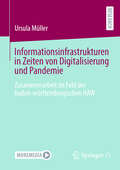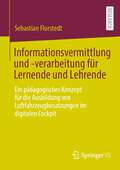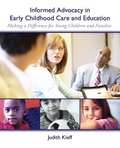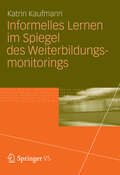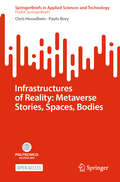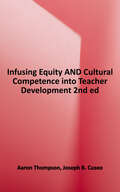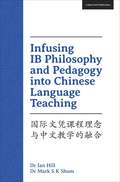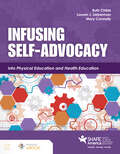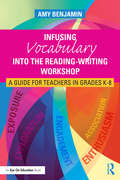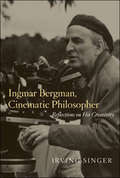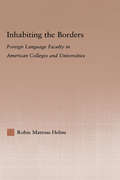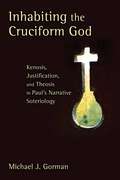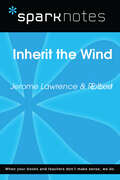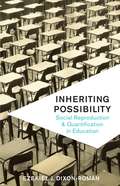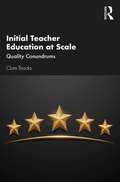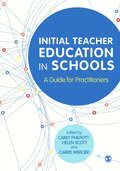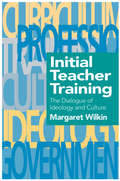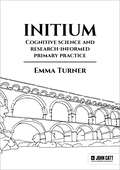- Table View
- List View
Informationsinfrastrukturen in Zeiten von Digitalisierung und Pandemie: Zusammenarbeit im Feld der baden-württembergischen HAW
by Ursula MüllerDieses Buch untersucht die Zusammenarbeit zwischen den Informationsinfrastruktureinheiten (IE) an Hochschulen für Angewandte Wissenschaften (HAW) in Baden-Württemberg im Kontext der Digitalisierung und der COVID-19-Pandemie. Anhand einer neo-institutionalistisch inspirierten, explorativen Studie mit einem vergleichenden Fallstudienansatz wird untersucht, wie sich die hochschulübergreifende und innerhochschulische Zusammenarbeit der IE seit der gesetzlichen Verpflichtung zu mehr Integration aus dem Jahr 2005 verändert haben. Die Ergebnisse zeigen, dass sich zwar (mit Ausnahme des Unterfeldes der HAW-Medienzentren bzw. E-Learning-Support-Einheiten) zumindest die Unterfelder der Hochschulrechenzentren und Hochschulbibliotheken stärker konstituiert haben, es aber nach wie vor Hindernisse für eine weitere Intensivierung und insbesondere für eine weitere unterfeldübergreifende Zusammenarbeit gab. Auch die tatsächlich beobachtete Integration im Inneren der Fallhochschulen blieb hinter den Erwartungen zurück und es zeigten sich keine „überlegenen“ institutionellen Lösungen. Somit scheint die gesetzliche Forderung nach mehr innerhochschulischer Integration (zumindest hinsichtlich formal integrierter Organisationsstrukturen) nur bedingt eine zielgerechte Umsetzung erfahren zu haben.
Informationsvermittlung und -verarbeitung für Lernende und Lehrende: Ein pädagogisches Konzept für die Ausbildung von Luftfahrzeugbesatzungen im digitalen Cockpit
by Sebastian FlorstedtMit der Einführung des digitalen Cockpits wurde der Arbeitsplatz für Luftfahrzeugbesatzungen im Bereich Mensch-Maschine-Interaktion neu erfunden. Moderne und zukünftige Luftfahrzeuge lassen sich nahezu problemlos steuern, verfügen jedoch über Schnittstellen, welche die Besatzung mit zuvor unbekannten Informationen versorgen. Menschen verlieren den Blick für das Wesentliche, nämlich die Wahrnehmung der relevanten Umweltfaktoren zum Schaffen eines Situationsbewusstseins. Dynamische und komplexe Situationen gilt es intuitiv zu erfassen, um zeitkritische Entscheidungen treffen zu können. Irrelevante Informationen müssen hingegen vernachlässigt werden, um die Auswahl einer Handlung nicht durch Analyseprozesse aufzuhalten. Das vorliegende Ausbildungskonzept wurde im Flugsimulator-Experiment mittels Teiltheorien validiert, welche sich insbesondere auf die Schaffung des mentalen Modells der Umwelt fokussieren. Die Anwendbarkeit des Konzeptes gilt für Tätigkeitsfelder, in denen eine langjährige Ausbildung unter verschieden Umweltsituationen, welche wenig Fehler verzeihen, nötig ist. Diese Arbeit dient einerseits als Lehrwerk und Nachschlagewerk in der Ausbildungsdurchführung und Interaktion zwischen Lehrenden und Lernenden. Andererseits dient das Konzept branchenübergreifend als ein strategisch-taktischer Leitfaden zum taktisch-operativen Ausbildungsdesign.
Informatische Bildung im Sachunterricht: Evaluationsstudie zum code.org Express Kurs 2021 (BestMasters)
by Viola BackhausIn diesem Buch geht es um Informatische Bildung im Sachunterricht. Darüber, dass das Lernen über und das Lernen mit digitalen Medien Teil der allgemeinen Bildung sein muss, besteht seit Anfang der 2010er Jahre weitestgehend ein Konsens in den politischen, gesellschaftlichen und bildungswissenschaftlichen Diskursen. Wie jedoch das Digitale in die Schule kommen kann, wird weiterhin diskutiert. Insbesondere zur informatischen Bildung in der Elementar- und Primarstufe ist noch vieles ungeklärt. Die Frage nach fundierten didaktischen Ansätzen zur informatischen Bildung in der Primarstufe ist daher besonders relevant für den Forschungsdiskurs des Sachunterrichts: Die Lebenswelt der Kinder, die zu ergründen der Sachunterricht zum Ziel hat, wird durch die Digitalisierung stark beeinflusst. Das primäre Anliegen der Autorin ist es, einen konkreten informatikbezogenen Lehrgang (code.org Express Kurs 2021) wissenschaftlich zu evaluieren und hinsichtlich seiner Praxistauglichkeit zu bewerten. Da zur Messung von informatischen Kompetenzen in der Primarstufe noch kein wissenschaftlich fundiertes Instrument verfügbar ist, wurde ein eigener Test entwickelt, der hier mit der Evaluationsstudie beschrieben und diskutiert wird.
Informed Advocacy in Early Childhood Care and Education: Making a Difference for Young Children and Families
by Judith E. Kieff<p>This practical guide describes the critical need for advocacy in the field of early care and extols the ethical responsibilities of all early child educators, as outlined in the Code of Ethical Conduct (NAEYC 2005). Organized into three parts, the text begins with advocacy in the field of early childhood education, discusses how to develop an advocacy agenda, and concludes with becoming an advocate for life. <p>Additionally, the author outlines six contexts for advocacy in the field of early childhood -- individual child and family, advocacy for the profession, program-based advocacy, private-sector advocacy, political activism, and advocacy in the global arena.
Informelles Lernen im Spiegel des Weiterbildungsmonitorings
by Katrin KaufmannTrotz der zunehmenden - vor allem bildungspolitisch geprägten - Bedeutungszuschreibung des informellen Lernens als relevante Form der Bildungsbeteiligung Erwachsener, liegen in und für Deutschland aktuell keine Längsschnitt- oder Trendanalysen zur tatsächlichen Beteiligung vor. Auf der Grundlage der Scientific-Use-Files der Querschnitterhebungen 1994-2007 des Berichtssystems Weiterbildung (BSW) wurden für diese Studie die Möglichkeiten und Grenzen trendanalytischer Betrachtungen des informellen berufsbezogenen Lernens untersucht. Fokussiert werden Funktionen und kontextuelle Einbindungen in Erwerbstätigkeit der informellen Lernaktivitäten. Im Ergebnis zeigt sich einerseits die Relevanz einer differenzierteren Betrachtung informellen Lernens Erwachsener und darüber hinaus werden die Möglichkeiten trendanalytischer Betrachtungen von Beteiligungsmustern unter sich ändernden Erhebungsformaten deutlich.
Informing Instruction with Vignette Analysis: Powerful Professional Growth for Middle and High School Teachers
by Paul J. Vermette Kimberly Alexander Mary Ellen Bardsley Charles Howard GonzalezDiscover how to improve classroom instruction with vignette analysis, an engaging and relevant form of professional development. The book features a wide variety of vignettes—from across 6–12 content areas such as English language arts, math, science, and social studies—designed to help teachers spot practices they like (or don’t like) and help them to connect the teaching practices described to well-established and research-supported frameworks. Each vignette is followed by an analysis of the lesson, which includes questions, prompts, and ideas of how to continue the conversation for pre- and in-service teachers as well as teacher educators on an individual basis, small groups, or as a class.
Infrastructures of Reality: Metaverse Stories, Spaces, Bodies (SpringerBriefs in Applied Sciences and Technology)
by Chris Hesselbein Paolo BoryThis open access book focuses on two dimensions of the development of the metaverse that are crucial to &‘reality&’, namely spatiality and embodiment. Metaversal technologies are thought to fundamentally affect both our spaces and bodies, which are two central aspects of the constitution of social reality. Both spatiality and embodiment are core elements of world-making that are being pulled into the ambit of metaversal projects. On the one hand, metaversal technologies are profoundly spatial in the sense that they render space in virtual form or overlay digital layers onto pre-existing physical spaces. On the other hand, metaversal technologies are directly geared towards the body in that they not only seek to extend or expand our embodied senses and emplace our bodies in virtual spaces, but they also seek to capture their behaviours and actions on a far more granular level. This can create new opportunities in terms of work, social interaction, and leisure, but can also open our bodies up to new, tech-driven interventions and control. Whether in the form of VR or AR, such technologies not only reproduce space but also rely on making spaces more legible and open to automated interventions. Taken together, the &‘metaversification&’ of spaces and bodies gives rise to crucial questions about the goals and implications of metaversal developments by large technology companies and about the relationship between the developments of the metaverse and AI systems. Drawing on our combined background and expertise in Science and Technology Studies and the History of Media and Communication, we critically analyse the development of metaversal technologies and platforms by discussing a broad set of developments and examples from a wide range of technology and gaming companies. Written in clear, concise, and accessible language, and combining and applying novel theoretical frameworks and concepts to a currently emergent phenomenon, this book will find a large audience not only within academic and professional circles but also in popular culture.
Infusing Critical Thinking Into Your Course: A Concrete, Practical Approach
by Linda B. NilsonCritical thinking—every scholar in the literature has defined it, but there is no clearly agreed upon definition. No wonder polls and surveys reveal that few college-level faculty can define critical thinking or know how to teach it. Still, critical thinking keeps appearing in accreditation standards and surveys of the skills employers seek in college graduates. The good news is that we do know that critical thinking can be taught. But the concept cries out for the simplification, translation into discipline-relevant course outcomes, tangible teaching strategies, and concrete assessment techniques that this book will provide.Like a course or a workshop, this book proposes learning outcomes for the reader—promises of what the reader will be able to do after reading it. These include:• explain what critical thinking is in simple terms;• convincingly explain to students why it is important for them to learn critical thinking, and, if they tune out, what they stand to lose;• overcome the challenges that teaching critical thinking presents;• identify the type of course content to which critical thinking can be applied and, therefore, that readers can use to teach critical thinking;• integrate critical thinking into the design of a new or existing course in any discipline;• write assessable critical thinking learning outcomes that are compatible with and make sense in any discipline;• select and adapt activities and assignments that will give students no- or low-stakes practice with feedback in critical thinking using a variety of questions, tasks, and teaching methods.
Infusing Equity and Cultural Competence into Teacher Development
by Aaron Thompson Joseph B. CuseoAs teachers face increasing diversity within their classrooms in learning styles, race, linguistics, and culture, the academic rigor needed to successfully enter college or a career will require them to evolve in order for all students to succeed. <p><p> Infusing Diversity & Cultural Competence into Teacher Education provides educators and future educators with pathways for achieving cultural competence. Placing this crucial competence in the teacher’s toolbox will increase their opportunity and the capacity of ensuring success in and out of the classroom. The tools presented in this book assist the teacher in making gains in closing achievement gaps, building opportunity for all students, building strong pedagogical skills, enhancing curriculum for their diverse students, and constantly assessing all of these areas to ensure they are maintaining their status as the largest contributor to students’ success. <p><p> Infusing Diversity & Cultural Competence into Teacher Education: <p> Defines, describes, and explains why diversity should be part of the formal education process <p>Illustrates student, family, school, and community roles in the learning process. <p>Describes how to incorporate intercultural communication and relationship building skills into curriculum.
Infusing Grammar Into the Writer's Workshop: A Guide for K-6 Teachers
by Amy Benjamin Barbara GolubHelp your students improve their language skills and become stronger readers and writers. In this timely book, literacy experts Amy Benjamin and Barbara Golub offer best practices for fortifying the writer’s workshop model with meaningful, relevant instruction in grammar. The book answers questions such as… What does a writer’s workshop look like and how does it fit into balanced literacy models? How does grammar fit into a writer’s workshop? How can you use natural language acquisition to transition children from non-Standard to Standard English patterns? How can you teach students to identify a complete sentence? What are effective ways to teach parts of speech? How can you build on nouns and verbs to teach adjectives, adverbs, prepositional phrases, and dependent clauses? In each chapter, you’ll find out exactly what teaching the targeted concept looks like in a workshop classroom. Examples are provided for different grade levels and can be adapted as necessary to meet your needs. This book is a No-Worksheet Zone. You’ll learnhow to present grammar using authentic text and talk, leading to more durable learning.
Infusing IB Philosophy and Pedagogy into Chinese Language Teaching
by Mark S. ShumThis book not only examines what IB philosophy is, it also explores the relationship between IB philosophy and Chinese language and culture and introduces a lot of useful and creative teaching pedagogies and methodologies. Most importantly, this book fills the gap of implementing IB philosophy and pedagogy into Chinese language teaching.
Infusing IB Philosophy and Pedagogy into Chinese Language Teaching
by Mark S. ShumThis book not only examines what IB philosophy is, it also explores the relationship between IB philosophy and Chinese language and culture and introduces a lot of useful and creative teaching pedagogies and methodologies. Most importantly, this book fills the gap of implementing IB philosophy and pedagogy into Chinese language teaching.
Infusing Self-Advocacy into Physical Education and Health Education
by Lauren J Lieberman Ruth Childs Mary ConnollySelf-advocacy is a key component to meeting the standards in health, physical education, and social-emotional learning. Infusing Self-Advocacy in Health and Physical Education is a unique publication that provides an interdisciplinary approach to promote the benefits of self-advocacy for every child. Through the use of key teaching and learning elements, like real-world scenarios, lessons, and equity and inclusion sections, the text ensures that all instructors are equip with tools to prepare students for life's challenges.
Infusing Vocabulary Into the Reading-Writing Workshop: A Guide for Teachers in Grades K-8
by Amy BenjaminLearn how to make vocabulary instruction more effective by making better use of mini-lessons and word study time to achieve durable learning about words and how they work. In this essential new book, literacy expert Amy Benjamin presents her 4E model (Exposure, Exploration, Engagement, Energy) for teaching vocabulary so that students gain deep understanding, improving their overall language and literacy skills. Benjamin guides you through bringing these 4Es to life in your K-8 reading-writing workshop. -Exposure: Enrich your teacher talk with sophisticated words and phrases to facilitate natural language acquisition and application of new words. -Exploration: Promote consistent vocabulary growth with a multifaceted instructional approach that incorporates etymology, word associations, word families, spelling, and morphology. -Engagement: Build students’ confidence by encouraging meaningful use of new words, both in and out of the classroom. -Energy: Enliven your workshop and increase participation with a variety of word games, puzzles, projects, and cooperative learning activities. Each chapter provides practical examples and scenarios to help you apply the model to your own classroom. The appendices include a variety of strategies for organizing reading-writing workshops, a thorough introduction to academic word lists and their role in vocabulary instruction, and an analysis of forty Latin and Greek word roots for mini-lessons.
Ingmar Bergman, Cinematic Philosopher: Reflections on His Creativity (The Irving Singer Library)
by Irving SingerThe development of themes, motifs, and techniques in Bergman's films, from the first intimations in the early work to the consummate resolutions in the final movies.Known for their repeating motifs and signature tropes, the films of Ingmar Bergman also contain extensive variation and development. In these reflections on Bergman's artistry and thought, Irving Singer discerns distinctive themes in Bergman's filmmaking, from first intimations in the early work to consummate resolutions in the later movies. Singer demonstrates that while Bergman's output is not philosophy on celluloid, it attains an expressive and purely aesthetic truthfulness that can be considered philosophical in a broader sense. Through analysis of both narrative and filmic effects, Singer probes Bergman's mythmaking and his reliance upon the magic inherent in his cinematic techniques. Singer traces throughout the evolution of Bergman's ideas about life and death, and about the possibility of happiness and interpersonal love. In the overtly self-referential films that he wrote or directed (The Best Intentions, Fanny and Alexander, Sunday's Children) as well as the less obviously autobiographical ones (including Wild Strawberries, The Seventh Seal, and the triad that begins with Through a Glass Darkly) Bergman investigates problems in his existence and frequently reverts to childhood memories. In such movies as Smiles of a Summer Night, Scenes from a Marriage, and Saraband, Bergman draws upon his mature experience and depicts the troubled relationships between men who are often weak and women who are made to suffer by the damaged men with whom they live. In Persona, Cries and Whispers, and other works, his experiments with the camera are uniquely masterful. Inspecting the panorama of Bergman's art, Singer shows how the endless search for human contact motivates the content of his films and reflects Bergman's profound perspective on the world.
Inhabiting the Borders: Foreign Language Faculty in American Colleges and Universities (Studies in Higher Education)
by Robin Matross HelmsThis book focuses on the experience of foreign language faculty in American colleges and universities, the challenges they face, and ways that academia can better support language faculty, and marginalized faculty in other fields, in their important work.
Inhabiting the Cruciform God: Kenosis, Justification, and Theosis in Paul's Narrative Soteriology
by Michael J. GormanIn this groundbreaking study of Paul's soteriology, Michael Gorman builds on his influentialCruciformity: Paul's Narrative Spirituality of the Cross to argue that cruciformity is, at its heart,theoformity -- what the Christian tradition has called theosis or participation in the life of God."A richly synthetic reading of Paul. . . . Gorman deftly integrates the results of recent debates about Pauline theology into a powerful constructive account that overcomes unfruitful dichotomies and transcends recent controversies between the 'New Perspective on Paul' and its traditionalist critics. Gorman's important book points the way forward for understanding the nonviolent, world-transforming character of Paul's gospel."-- Richard B. Hays, Duke Divinity School
Inhabiting ‘Childhood’
by Sarada BalagopalanThrough a rich ethnography of street and working children in Calcutta, India, this book offers the first sustained enquiry into postcolonial childhoods, arguing that the lingering effects of colonialism are central to comprehending why these children struggle to inhabit the transition from labour to schooling.
Inherit the Wind (SparkNotes Literature Guide Series)
by SparkNotesInherit the Wind (SparkNotes Literature Guide) by Jerome Lawrence Making the reading experience fun! Created by Harvard students for students everywhere, SparkNotes is a new breed of study guide: smarter, better, faster. Geared to what today's students need to know, SparkNotes provides: *Chapter-by-chapter analysis *Explanations of key themes, motifs, and symbols *A review quiz and essay topicsLively and accessible, these guides are perfect for late-night studying and writing papers
Inheriting Possibility: Social Reproduction and Quantification in Education
by Ezekiel J. Dixon-RománHow has the dominant social scientific paradigm limited our understanding of the impact of inherited economic resources, social privilege, and sociocultural practices on multigenerational inequality? In what ways might multiple forces of social difference haunt quantitative measurements of ability such as the SAT? Building on new materialist philosophy, Inheriting Possibility rethinks methods of quantification and theories of social reproduction in education, demonstrating that test performance results and parenting practices convey the impact of materially and historically contingent patterns of differential possibility.Ezekiel J. Dixon-Román explores the dualism of nature and culture that has undergirded theories of inheritance, social reproduction, and human learning and development. Research and debate on the reproduction of power relations have rested on a premise that nature is made up of fixed universals on which the creative, intellective, and discursive play of culture are based. Drawing on recent work in the physical and biological sciences, Dixon-Román argues that nature is culture. He contends that by assuming a rigid nature/culture binary, we ultimately limit our understanding of how power relations are reproduced. Through innovative analyses of empirical data and cultural artifacts, Dixon-Román boldly reconsiders how we conceptualize the processes of inheritance and approach social inquiry in order to profoundly sharpen understanding and address the reproducing forces of inequality.
Initial Teacher Education at Scale: Quality Conundrums
by Clare BrooksDebates about what constitutes quality in initial teacher education have resulted in a series of quality conundrums that have to be unravelled by teacher educators. Using the lens of scale and adopting a new approach to understanding quality, this book draws upon empirical research into five large-scale, high-quality university-based teacher education providers in Australia, Canada, England, New Zealand and the US. The resulting model of initial teacher education practice shows how ideological concepts and accountability structures around teacher education are in constant tension with operational realities. The book explores how successful large-scale providers have reconciled those tensions and conundrums to ensure their provision is consistently high quality. The accounts also present a robust defence for university-based teacher education. The practice-based accounts of how tensions around quality and scale are being reconciled reveal the competing discourses around teacher professionalism, research and the role of the university in teacher education. The analysis presented promises to change the way we view high-quality teacher education across all providers and international contexts, not just those of large scale. This book will be of great interest to teacher educators, policymakers and educational leaders.
Initial Teacher Education in Schools: A Guide for Practitioners
by Helen Scott Carrie Mercier Carey PhilpottSuccessfully establishing initial teacher education courses in schools requires a careful understanding of what it means to train someone to teach. This book provides guidance on how teacher training can be effective in school-based settings. Essential practical issues are covered including, recruitment, pastoral care and the organization of academic components of a course. It also covers conceptual topics such as: what makes a good mentor? models of learning suitable for teacher education the role of evidence-based teaching in a practical setting Examples from existing primary and secondary school-based programmes explore good practice and show how challenges to developing courses can be overcome.
Initial Teacher Education in Schools: A Guide for Practitioners
by Helen Scott Carrie Mercier Carey PhilpottSuccessfully establishing initial teacher education courses in schools requires a careful understanding of what it means to train someone to teach. This book provides guidance on how teacher training can be effective in school-based settings. Essential practical issues are covered including, recruitment, pastoral care and the organization of academic components of a course. It also covers conceptual topics such as: what makes a good mentor? models of learning suitable for teacher education the role of evidence-based teaching in a practical setting Examples from existing primary and secondary school-based programmes explore good practice and show how challenges to developing courses can be overcome.
Initial Teacher Training: The Dialogue Of Ideology And Culture
by Margaret Wilkin Educational Researcher, The Research Unit, Homerton College, Cambridge.This text provides an account of the relationship between successive British governments and the profession of initial teacher training since the 1960s. In the 1970s, the Robbins Report led to the introduction of a curriculum which both structurally and substantively represented the ideology of the day: social democracy. More recent government initiatives have re-created training in market image.; Currently, this relationship is seen as one-sided, the government apparently dominating the curriculum through a series of legislative measures. The author, however, suggests that a long-term view of this relationship may reveal a different picture - that the relationship is interactive and beneficial to both sides, and can therefore be regarded as a dialogue.
Initium: Cognitive science and research-informed primary practice
by Emma TurnerThe beginnings of all things are small, but the possibilities for our primary pupils are infinite.Many books explore the wonders of science and education research but few are rooted in the reality of the primary classroom, what it is really like to run a primary classroom, and to spend each day in the fascinating company of our youngest learners. Initium looks with care and specific attention at the needs of our youngest learners, the development of age and stage appropriate practice and pedagogy, alongside the joys and realities of working within the primary phase.Primary is a unique stage of a child's development and requires a specific and distinctive approach to how we structure teaching and learning. What works at age 16 or 14 won't necessarily work with a classroom of 6-year-olds. Informed by science and rooted in over 25 years of primary expertise, Initium is research-informed practice for the primary specialist.
